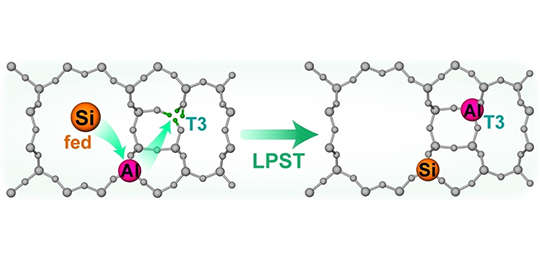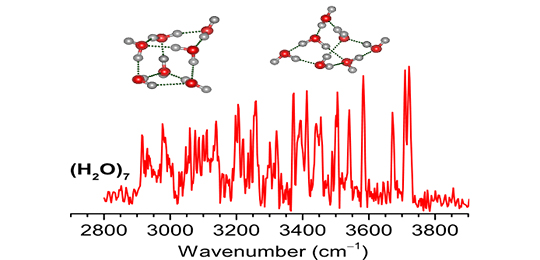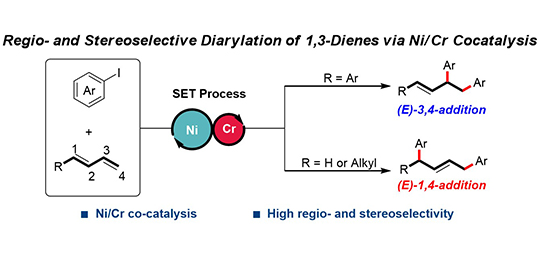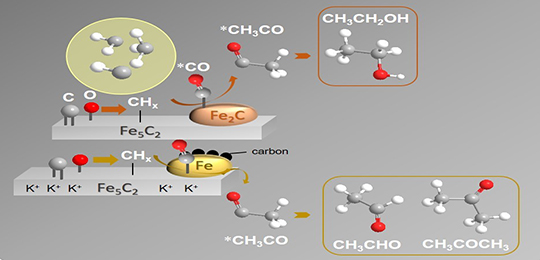Research News
-
 03 09, 2022New Strategy Developed to Control Site of Aluminum Atoms in Zeolite FrameworkScientists developed a new strategy to relocate mordenite (MOR) framework Al atoms into the desired T3 sites by a low-pressure SiCl4 treatment (LPST). The treated MOR catalysts presented good catalytic performance on the dimethyl ether (DME) carbonylation to methyl acetate (MA) reaction.
03 09, 2022New Strategy Developed to Control Site of Aluminum Atoms in Zeolite FrameworkScientists developed a new strategy to relocate mordenite (MOR) framework Al atoms into the desired T3 sites by a low-pressure SiCl4 treatment (LPST). The treated MOR catalysts presented good catalytic performance on the dimethyl ether (DME) carbonylation to methyl acetate (MA) reaction.
Zeolites are widely used in adsorption separation, ion exchange, and heterogeneous catalysis.
The site of acidity-related aluminum atoms in the zeolite framework is critical for the physicochemical performances of the zeolite.
Recently, a research team led by Profs. LIU Zhongmin from the Dalian Institute of Chemical Physics (DICP) of the Chinese Academy of Sciences (CAS) developed a new strategy to control the site of Al atoms in zeolite framework.
This study was published in Angewandte Chemie International Edition on Feb. 22.
a) Sketch map of a typical treatment process, showing the directional migration of framework Al into T3 sites of the MOR zeolite via LPST; b) The topology of MOR and the steric configuration of SiCl4and AlCl3 molecules with a kinetic diameter of 7.0 and 6.7 ?, respectively (Image by LIU Rongsheng)
In the strategy, the researchers relocated mordenite (MOR) framework Al atoms into the desired T3 sites by low-pressure SiCl4 treatment (LPST). The prepared MOR catalysts showed good catalytic performance in dimethyl ether carbonylation to methyl acetate reaction.
Furthermore, they investigated the change of framework compositions for the samples before and after LPST. They found that there were three stages during the treated reaction: Al extraction stage, Al migration stage and Al Insertion stage.
In Al extraction stage, due to the restriction of molecular size, SiCl4 could selectively access 12-membered ring (MR) rather than 8-MR channels. As SiCl4 molecules diffused into the 12-MR, they preferentially reacted with the framework Al in 12-MR with the release of AlCl3. That is to say, the undesired framework Al was extracted as a form of AlCl3 via replacing by Si.
As for Al migration stage, the AlCl3 molecule, which was more easily distorted owing to its plane triangle configuration, could migrate into 8-MR channels through the side pockets.
In Al Insertion stage, the AlCl3 could react with silanol defects of 8-MR channels to insert Al into T3 sites as tetrahedrally coordinated species.
Moreover, they used high-field 27Al nuclear magnetic resonance to identify the exact location of framework Al for the MOR samples. The results indicated that 73% of the framework Al atoms were at the T3 sites after LPST under optimal conditions, forming reactively favorable active sites (about 90%) in 8-MR channels. Therefore, it could controllably generate and intensify active sites in MOR zeolite for dimethyl ether (DME) carbonylation reaction with higher methyl acetate (MA) selectivity and much longer lifetime.
"This work puts forward a facile strategy for directionally relocating framework Al among the different T-sites of the MOR zeolite and potentially applicating it in other zeolites to control Al location," said Prof. LIU.
This work was supported by the National Natural Science Foundation of China, the International Partnership Program of CAS, the Key Research Program of Frontier Sciences of CAS. (Text by LIU Rongsheng) -
 03 07, 2022World’s First Pilot Project Producing Gasoline from CO2 Hydrogenation Completes Trial Operation
03 07, 2022World’s First Pilot Project Producing Gasoline from CO2 Hydrogenation Completes Trial Operation
The world's first demonstration device for 1,000 tons/year production of gasoline from carbon dioxide (CO2) hydrogenation located in Zoucheng Industrial Park, Shandong province, China has completed its trial operation and technology assessment on March 4.
The project was jointly developed by the Dalian Institute of Chemical Physics (DICP) of the Chinese Academy of Sciences (CAS) and Zhuhai Futian Energy Technology Co., Ltd.
Pilot plant for the production of 1000 tons/year gasoline from carbon dioxide (CO2) hydrogenation (Image by HOU Shoufu)
Hydrogenation of CO2 into liquid fuels and chemicals can not only realize the resource utilization of CO2, but also facilitate the storage and transportation of renewable energy.
However, the activation and selective conversion of CO2 are challenging. A technology that can selectively produce value-added hydrocarbon fuels with high energy density will provide a new route for promoting clean and low-carbon energy revolution.
The technology of carbon dioxide hydrogenation to gasoline was proposed by SUN Jian, GE Qingjie and WEI Jian from DICP in 2017, with a paper published in Nature Communications.
The demonstration device has been completed in Zoucheng Industrial Park, in 2020. In October 2021, the device passed the continuous 72-hour on-site assessment organized by China Petroleum and Chemical Industry Federation (CPCIF). It could realize both CO2 and H2 conversion of 95%, gasoline selectivity of 85% in all carbon-based products, with reduced consumption of the raw material of CO2 and H2.
It produced clean and green gasoline product with octane number more than 90 conforming to the Chinese national VI standard, accompanied by low energy consumption of the whole process.
"This technology marks a new stage of CO2 resource utilization technology in the world, and provides a new strategy for realizing the goal of carbon neutral," said Prof. SUN.
This work was supported by the Strategic Priority Research Program of "Key Technologies and Demonstration of Transformative Clean Energy" of CAS, the National Natural Science Foundation of China, and the Liaoning Talents Program. (Image by SUN Jian, GE Qingjie and WEI Jian) -
 03 07, 2022Scientists Discover Structural Complexity of Ice-like ClustersScientists has revealed the structural complexity of ice-like clusters.
03 07, 2022Scientists Discover Structural Complexity of Ice-like ClustersScientists has revealed the structural complexity of ice-like clusters.
The water heptamer, (H2O)7, is significant in the context of so-called amorphous precursor to the "crystal-like" cubic structures. The neutral (H2O)7 ice-like cluster is a key species in understanding the hydrogen-bonding network transitions between liquid water and ice.
Recently, a research team led by Prof. JIANG Ling and Prof. YANG Xueming from the Dalian Institute of Chemical Physics (DICP) of the Chinese Academy of Sciences, in collaboration with Prof. LI Jun from Tsinghua University, has revealed the structural complexity of ice-like clusters.
The study was published in Cell Reports Physical Science on February 1.
Prof. JIANG's and Prof. YANG's group developed a method of infrared spectroscopy of neutral clusters based on a tunable vacuum ultraviolet free electron laser (VUV-FEL). This method provides a new opportunity for the study of vibrational spectra of a wide variety of neutral clusters that could not be studied before.
They measured infrared(IR) spectra of size-selected neutral (H2O)7 using the VUV-FEL-based IR scheme. A variety of diverse bands observed in the IR spectrum of the water heptamer provide evidence for the presence of various low-lying structures at finite temperatures.
Prof. LI's team carried out quantum chemical studies to identify the structure of the low-lying isomers and to assign the observed IR spectral features.
The consistency of the experimental and calculated infrared spectra establishes general trends in the structural motifs. They found that the major contribution for the experimental spectrum originates from the prism-like isomers, although the minor contribution of the higher-energy cage-like isomers was non-negligible.
This study improved the understanding of structural diversity and complexity of water heptamer in the context of the formation and growth of ordered structures in larger systems. (Text by LI Gang and WANG Chong) -
 03 02, 2022Researchers Realize NHK Reaction of Alkenes and Arylhalides via Ni/Cr CocatalysisResearchers developed a regio- and stereoselective diarylation of 1,3-dienes via Ni/Cr cocatalysis to realize (E)-3,4-addition or (E)-1,4-addition respectively.A research team led by Prof. CHEN Qing'an from the Dalian Institute of Chemical Physics (DICP) of the Chinese Academy of Sciences (CAS) has realized Nozaki-Hiyama-Kishi (NHK) reaction of alkenes and arylhalides under Ni/Cr cocatalysis.Their findings were published in ACS Catalysis on Jan. 31.Nozaki-Hiyama-Kishi (NHK) reaction is important in synthetic chemistry, which features Ni/Cr-catalyzed coupling between aldehydes and arylhalides.However, compared with conventional aldehydes, alkenes cannot form thermodynamically favored metal-oxygen bonds, thus their NHK reactions have not been achieved yet.In this study, the researchers realized NHK reaction of 1,3-dienes and arylhalides with the assistance of redox active bis(imino)pyridine (PDI) ligand, through which diarylated products can be obtained with high regio- and stereoselectivities. "The key to success relies on the involvement of radical process. CrCl2 serves as a single-electron reductant for the formation of Ni(I) species and aryl radical," said Prof. CHEN.Besides, the resulting diarylated products can be easily transformed into valuable polyaryl thiophene and naphthalene that are interesting building blocks for the manufacture of advanced functional materials."This work is an important complement to NHK reaction. It also provides a paradigm for exploring new functionalization of dienes," said Prof. CHEN.The research was supported by Dalian Outstanding Young Scientific Talent and the National Natural Science Foundation of China.
03 02, 2022Researchers Realize NHK Reaction of Alkenes and Arylhalides via Ni/Cr CocatalysisResearchers developed a regio- and stereoselective diarylation of 1,3-dienes via Ni/Cr cocatalysis to realize (E)-3,4-addition or (E)-1,4-addition respectively.A research team led by Prof. CHEN Qing'an from the Dalian Institute of Chemical Physics (DICP) of the Chinese Academy of Sciences (CAS) has realized Nozaki-Hiyama-Kishi (NHK) reaction of alkenes and arylhalides under Ni/Cr cocatalysis.Their findings were published in ACS Catalysis on Jan. 31.Nozaki-Hiyama-Kishi (NHK) reaction is important in synthetic chemistry, which features Ni/Cr-catalyzed coupling between aldehydes and arylhalides.However, compared with conventional aldehydes, alkenes cannot form thermodynamically favored metal-oxygen bonds, thus their NHK reactions have not been achieved yet.In this study, the researchers realized NHK reaction of 1,3-dienes and arylhalides with the assistance of redox active bis(imino)pyridine (PDI) ligand, through which diarylated products can be obtained with high regio- and stereoselectivities. "The key to success relies on the involvement of radical process. CrCl2 serves as a single-electron reductant for the formation of Ni(I) species and aryl radical," said Prof. CHEN.Besides, the resulting diarylated products can be easily transformed into valuable polyaryl thiophene and naphthalene that are interesting building blocks for the manufacture of advanced functional materials."This work is an important complement to NHK reaction. It also provides a paradigm for exploring new functionalization of dienes," said Prof. CHEN.The research was supported by Dalian Outstanding Young Scientific Talent and the National Natural Science Foundation of China. -
 02 25, 2022Scientists Realize Direct Conversion of Syngas into Higher Aldehydes and Ketones under Mild ConditionScientists has prepared unsaturated oxygenates from syngas and achieved the highly selective production of higher aldehydes and ketones from CO hydrogenation under a mild condition over alkali metal modified iron catalysts.
02 25, 2022Scientists Realize Direct Conversion of Syngas into Higher Aldehydes and Ketones under Mild ConditionScientists has prepared unsaturated oxygenates from syngas and achieved the highly selective production of higher aldehydes and ketones from CO hydrogenation under a mild condition over alkali metal modified iron catalysts.
Higher oxygenates, typically referred to alcohols, aldehydes and ketones, are widely used valuable chemicals.
Compared with traditional routes, the direct synthesis of higher oxygenates from syngas is a facile and eco-friendly process. However, the low oxygenate yield and active hydrogenation of aldehyde and ketone in this process restrict its industrial applications.
Recently, a research team led by Prof. SUN Jian and Prof. GE Qingjie from the Dalian Institute of Chemical Physics (DICP) of the Chinese Academy of Sciences (CAS) has prepared unsaturated oxygenates from syngas and achieved the highly selective production of higher aldehydes and ketones from CO hydrogenation under a mild condition over alkali metal modified iron catalysts.
This study was published in Applied Catalysis B: Environmental on Jan. 29.
Illustration for the reaction pathway of oxygenates production over Fe-based catalysts (Image by XU Jing)
The proposed alkali metal modified iron catalysts, which are synergistic Fe-K series catalysts, could realize the regulation of CO hydrogenation products to C2+ alcohols or C2+ aldehydes and ketones under a mild condition. At a mild temperature of 170°C, the oxygenate selectivity was up to nearly 70 wt%, 88% of which were aldehydes and ketones.
The characterizations results showed that the shift of aldehyde-ketone and alcohol was closely related to the electronic and structural effect of K promoter. Proper K promoter could adjust surface chemical environment of catalyst (C-rich and H-lean surface) and reaction intermediates for alcohol to aldehyde shift.
The researchers found that the CO non-dissociative sites from Fe2C to Fe by the addition of K could reduce the energy barrier of aldehyde formation, which was favorable for aldehyde production.
"This study provides a new idea for the design and application of catalysts to tune the different higher oxygenate distribution in CO hydrogenation," said Prof. SUN.
This work was supported by the National Natural Science Foundation of China, the Youth Innovation Promotion Association of CAS, and Liaoning Revitalization Talents Program. (Text by XU Jing) -
 02 24, 2022Scientists Synthesize All-inorganic Lead-free 0D Perovskite Crystals with Excitation-dependent EmissionScientists synthesized an all-inorganic 0D perovskite crystals with excitation-dependent emission behavior.
02 24, 2022Scientists Synthesize All-inorganic Lead-free 0D Perovskite Crystals with Excitation-dependent EmissionScientists synthesized an all-inorganic 0D perovskite crystals with excitation-dependent emission behavior.
Materials with excitation-dependent emission are promising in applictions in encrypted information storage, multicolor display and anti-counterfeiting fields.
Cs2ScCl5·H2O single crystals can show tunable emission colors and its PLQY can be largely enhanced by Sb doping (Image by ZHANG Ruiling)
Recently, a research group led by Prof. HAN Keli from the Dalian Institute of Chemical Physics (DICP) of the Chinese Academy of Sciences (CAS) synthesized an all-inorganic 0D perovskite Cs2ScCl5·H2O with excitation-dependent emission behavior.
This study was published in Laser & Photonics Reviews on February 5.
The emission color of Cs2ScCl5·H2O could be simply tuned from blue-green to white to yellow by changing excitation wavelengths.
The origin of the tunable emission was attributed to the contribution of two different self-trapped exciton (STE) states.
Moreover, the researchers doped Sb3+ ions into Cs2ScCl5·H2O single crystals, leading to enhanced photoluminescence with about 100% photoluminescence quantum yield.
"This work provides new insights into the excitation-dependent emission in all-inorganic semiconductors, and presents a strategy to develop environmentally-friendly high-performance emitters," said by Prof. HAN.
This study was supported by the National Natural Science Foundation of China. (Text by ZHANG Ruiling)